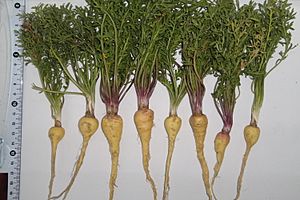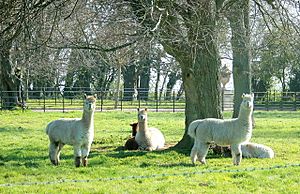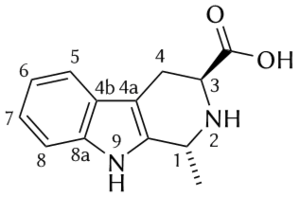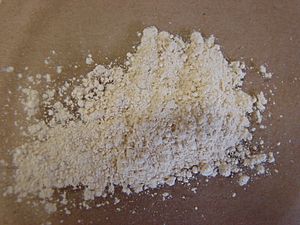Lepidium meyenii facts for kids
Quick facts for kids Lepidium meyenii |
|
|---|---|
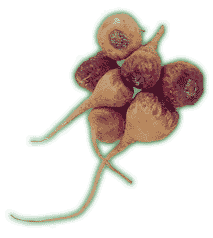 |
|
| Maca hypocotyl and root | |
| Scientific classification | |
| Genus: |
Lepidium
|
| Species: |
meyenii
|
| Synonyms | |
|
Lepidium peruvianum |
|
Maca, also known as Lepidium meyenii or Peruvian ginseng, is a special plant that grows high in the Andes mountains of Peru, in South America. It's an herb that lives for two years.
People grow maca for its root, which looks a bit like a turnip. This root is usually dried, but it can also be cooked fresh like a root vegetable. Once dried, it can be ground into a flour for baking or used in dietary supplements. It's also been used in traditional medicine for a long time.
In Spanish and Quechua, maca has other names like maca-maca, maino, ayak chichira, and ayak willku.
Contents
What Maca Looks Like
Maca plants look a lot like radishes or turnips, which are its relatives. Its green leaves grow close to the ground in a circle, like a rosette. They don't grow taller than about 12 to 20 centimeters (5-8 inches).
The plant has small, off-white flowers that grow on a central stem. After the flowers, tiny fruits appear, each holding two small reddish-gray seeds. These seeds are the only way maca plants reproduce. Maca mostly pollinates itself, meaning it doesn't need other plants to make seeds. A maca plant has 64 chromosomes in its genetic code.
The Maca Root
The most important part of the maca plant is its root. It's the only plant in its group that has a thick, fleshy root that connects to the main taproot. Maca roots come in many shapes, like triangles, flat circles, or even rectangles.
Traditionally, farmers have recognized four main types of maca based on their root color: cream-yellow, half purple, purple, and black. These colors come from different amounts of natural pigments called anthocyanins. Maca roots can also be gold, red, blue, or green. Each color is considered a unique type, as the seeds from a parent plant will grow roots of the same color.
Cream-colored roots are the most common and are liked in Peru because they are sweeter and larger. Black maca roots are both sweet and a little bitter.
How Maca is Grown
Where Maca Grows Best
Maca naturally grows in very high places, usually between 3,800 and 4,400 meters (12,500–14,400 feet) above sea level. In these areas, the temperature during the growing season can range from -2°C to 13°C (28°F to 55°F). It can get as cold as -10°C (14°F), and frosts are common. Maca is one of the few plants that can handle such cold temperatures. Strong winds and bright sunlight are also common in its native home.
Today, maca is mostly grown in Peru, in the high Andes mountains. Some is also grown in Bolivia and a small amount in Brazil. Maca can even be grown higher than 4,400 meters above sea level.
Maca's Life Cycle
Maca seedlings usually pop out of the ground about a month after planting, when the rainy season starts in October. The root grows bigger until May or June. After about 260 to 280 days, the root is ready to be harvested.
If the root is left in the soil, it rests for two to three months during the cold, dry season. Then, it will grow a shoot that produces seeds about five months later. One plant can make up to 1,000 tiny seeds! This means you don't need many plants to grow more maca.
Farmers choose plants with the best size and color for growing new crops. They plant them about 5-10 centimeters (2-4 inches) deep in holes, adding layers of grass and soil to keep them from drying out. Maca needs a lot of nutrients from the soil, so farmers fertilize the land.
Traditionally, farmers prepared the land by hand. Now, tractors are also used. Maca often grows in places where no other crops can survive. Farmers usually fertilize maca fields with sheep and alpaca manure. This helps keep the soil healthy.
Weeding or using pesticides is usually not needed because the climate is too harsh for most weeds or pests. Most maca in Peru is grown organically, meaning without chemicals. Maca is sometimes planted with potatoes because it helps keep away pests that bother root crops.
Harvesting Maca
Maca is harvested by hand. The leaves are left in the field to be used as livestock feed or as organic fertilizer for the soil.
A good harvest can yield about 15 tons of fresh maca roots per hectare (about 2.5 acres). This makes about 5 tons of dried maca. However, the average yield in Peru in 2005 was closer to 7 tons per hectare.
Even though maca has been grown outside the Andes, it's not clear if it has the same special qualities when grown in different places. Roots grown from Peruvian seeds often struggle to grow well in lower elevations, greenhouses, or warm climates.
Maca's Nutrients
When maca is dried, it's packed with good stuff! It's mostly made up of carbohydrates (60-75%), which give you energy. It also has a good amount of protein (10-14%), dietary fiber (8.5%), and some fats (2.2%).
Maca and Your Health
Maca contains natural plant compounds that scientists are still studying. Some of these compounds are also found in other plants.
It's important to know that scientists are still researching how maca affects the human body. Some studies have looked at certain compounds in maca and their possible effects. If you are thinking about trying maca or any new supplement, it's always a good idea to talk to a doctor or a trusted adult first. They can help you understand if it's right for you.
Maca in the Market
Maca became much more popular between the 1990s and 2014 because some people believed it could help with fertility. However, many people didn't like the taste of maca at first, which made it hard for it to become a popular food.
The main interest in maca came from its use in dietary supplements, where people hoped to get its health benefits, even though these benefits haven't been fully proven by science.
Around 2014, China also became very interested in growing and selling maca. This led to some disagreements with Peruvian groups, who said that Chinese companies were taking maca illegally and trying to patent it, which is called biopiracy.
How Maca is Used and Prepared
Maca is mostly grown for its root, which is often dried. Dried maca roots can be stored for several years. In Peru, maca is prepared and eaten in many ways, but it's almost always cooked.
Freshly harvested maca roots can be roasted in a pit, which is considered a special treat. Fresh roots are usually only found near where they are grown. The root can also be mashed and boiled to make a sweet, thick liquid. This liquid can then be dried and mixed with milk to make a porridge called mazamorra. Cooked maca roots are also used in empanadas (savory pastries), jams, or soups.
The root can be ground into a flour for making bread, cakes, or pancakes. If it's fermented, it can even be made into a weak beer called chicha de maca. In 2010, a company in the U.S. became the first to sell beer made from maca, called KUKA Beer. A strong drink is also made from black maca. The leaves of the maca plant can also be eaten raw in salads or cooked, similar to other related plants.
The main maca product sold around the world is maca flour, which is made from the hard, dried roots. It's called harina de maca. Maca flour is quite affordable, like wheat flour or potato flour. The supplement industry uses both dried roots and maca flour to make different types of concentrated extracts.
Another common form is "gelatinized" maca. This process uses gentle heat and pressure to remove the tough fibers from the roots. Raw maca can be hard to digest because of these fibers.
Archaeological findings show that maca has been grown in the Lake Junin area for a very long time, from about 1700 BC to 1200 AD. People in the puna grasslands of the Andes have been harvesting and using maca for centuries.
Even though some people claim maca was widely grown in Peru, until the late 1980s, it was mostly grown only in a small area around Lake Junin. Historically, maca was often traded for other foods from lower, warmer areas, like maize (corn), rice, manioc (tapioca roots), quinoa, and papaya. It was even used as a way to pay taxes to the Spanish rulers.
Maca in Traditional Medicine
Maca has been sold for its supposed uses in traditional medicine. However, there isn't strong scientific research to show that it can cure diseases or have a big effect on your health.
See also
 In Spanish: Maca para niños
In Spanish: Maca para niños


